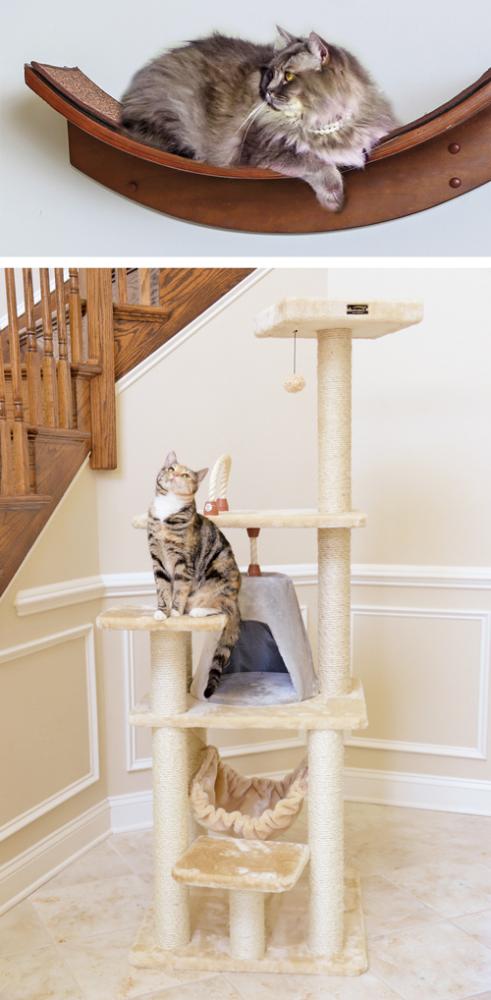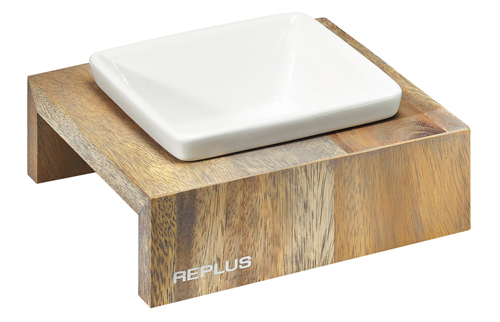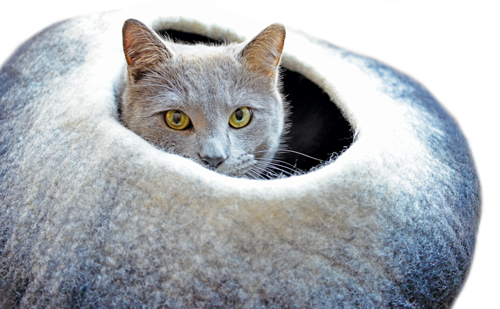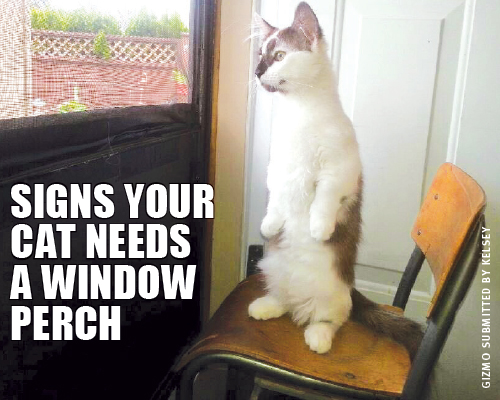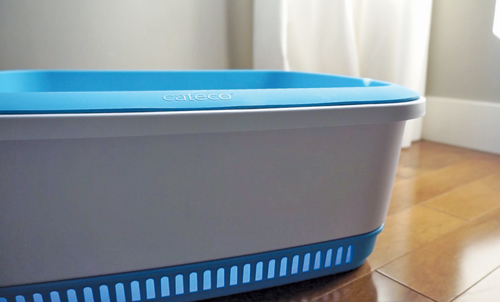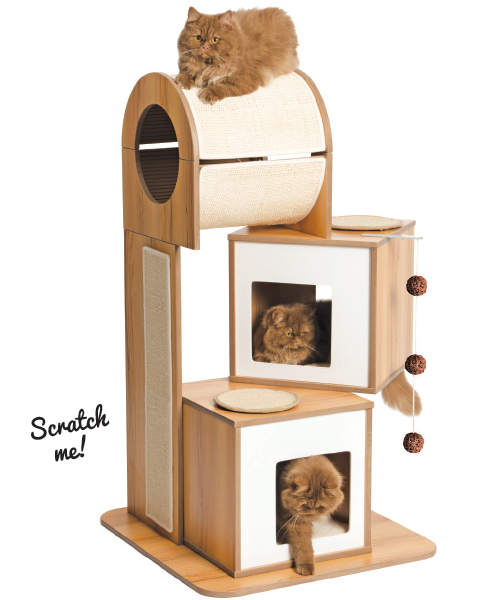

7 Steps to Creating a Cat Friendly Home
Make your home a haven for your cat
Your cat spends the majority of their time in your home so make sure it’s a kitty haven with these 7 tips for creating a cat friendly home!
1. Expand your cat’s world: create vertical space.
One of the most important aspects of creating a cat friendly home is making sure your cat has vertical space. The creation of vertical space is HUGE for cats. It opens up their space, makes it easier for cats in a multi-cat household to get along as they can “time-share” their space/assets because there are enough spots to go around, and it lets them survey their world from on high. It also encourages exercise, sorely lacking for many indoor cats, by giving them somewhere to jump to. There are many awesome (and attractive!) ways to create vertical space for your cats: amazing cat trees, cat shelves, and the connection of these vertical spaces to create “cat super highways.”
Pictured above: With high perches, playhouses, swinging ropes, ladders, and more, the Classic Cat Tree from Armarkat has something for every cat (from $45).
The beautiful Lotus Cat Shelves from Refined Feline provide an ideal up-top perch for your cat. Not only do they provide vertical space, but they’re supremely chic (from $64).
2. Provide a dining experience free of whisker stress.
Did you know the high sides of your cat’s dish bother his delicate whiskers? It’s true. Whiskers are extremely sensitive. A wide, low-sided dish suits cats best.
Pictured above: The Artisan Feeder from Bowsers (from $57) embodies utilitarian chic. The low sides won’t bother your cat’s whiskers and the neutral wood base and elegant white ceramic bowl add appropriate sophistication to dinnertime. Your cat approves.
3. Give your cat a cocoon, not a hideaway.
Every cat friendly home needs good places for your cat to hide away and snuggle up. You should therefore provide a spot for your cat to disappear in plain sight so he can still be a part of family life but feels safe and secure. If your cat is able to “hide” by crawling into a “secret” spot off to the side of the living room—such as that provided by the lovely Ombré Cat Cave from Karma Cat, handcrafted by women’s collectives high in Nepal with a blend of Tibetan and New Zealand wools ($65, distinctlyhimalayan.com)—as opposed to retreating to a spot under the bed, you’ll be able to help a nervous or scared cat build confidence and integrate with the family.
4. Offer a room with a view. Cats love to look out windows.
Create a lookout point for your cat with a window perch or an appropriately situated shelf or bookcase. You might never know what your cat is thinking about when they spend all day staring outside, but a perch is always a kitty favourite. Though be aware that the outdoor presence of neighbourhood cats can disquiet indoor cats.
5. The multi-bathroom home.
“Cat Daddy” Jackson Galaxy recommends the “plus one” rule, meaning when determining how many litter boxes you need, count the number of cats you have and add one; if you have two cats, you’ll want three litter boxes, situated in locations with social significance to your cats. Unfortunately, your cats would like their litter boxes placed where you spend most of your time. We get that you might not want a litter box in your living room but perhaps you can compromise; if your cats spend a lot of time by certain windows or doors, place the litter boxes in these spots or in the bathroom that you use.
6. No “gas station” bathrooms please.
Cats want a clean and non-stinky place to do their business and who can blame them? Consider improving your cat’s bathroom situation by upgrading to a litter box that fights odour issues. The design of the new Cateco litter box ($60) for instance, is clinically proven to reduce odours by up to 86 percent by fighting humidity and therefore bad smells. By optimizing natural air circulation it allows litter to dry properly, discouraging the growth of bacteria and fungus, aka the cause of stinky ammonia and other malodorous gases. Bonus—you’ll need to change your cat’s litter far less frequently!
7. Place scratching posts where your cat wants them, rather than where you want them.
There are a number of reasons your cat is choosing the sofa and the doorjamb of your bedroom for scratching. They are important locations to your cat, marking key territory. Just reflect how much time you spend between these two locations; your cat wants to leave her mark in these key outposts to indicate her co-ownership (Awww, it’s like a Facebook “in a relationship” status update!). Instead of tucking away scratching posts where you’d like them, place them in these spots (or wherever else your cat seems to want to scratch).
Make sure the scratching posts you choose are super sturdy and provide for a variety of scratching positions—horizontal (aka what the arm of your sofa used to provide), vertical, and inclined. “Scratchability” is also important—it doesn’t help that the couch and door frames are usually made of ideal scratching material, so make sure the alternative on offer is satisfying for your cat to sink her claws into. Remember, cats aren’t just making their mark when scratching but are also stretching their back muscles and removing the outer nail sheath.
Pictured above: Get your scratch on! Vesper V-line cat furniture (from $65, pictured $155) melds cat-friendly materials with elegant design, combining cozy cubes, platforms and tunnels with strategically placed scratching areas.
Join the newsletter and never miss out on cat content again!
"*" indicates required fields
By clicking the arrow, you agree to our web Terms of Use and Privacy & Cookie Policy. Easy unsubscribe links are provided in every email.





